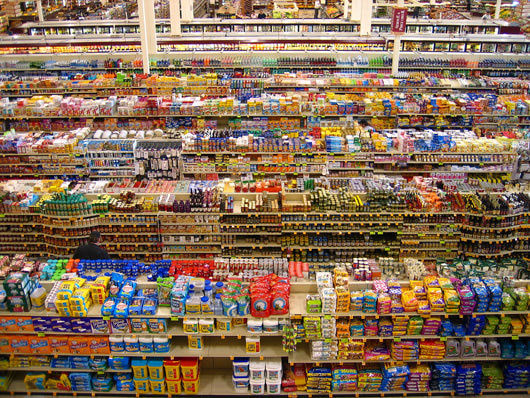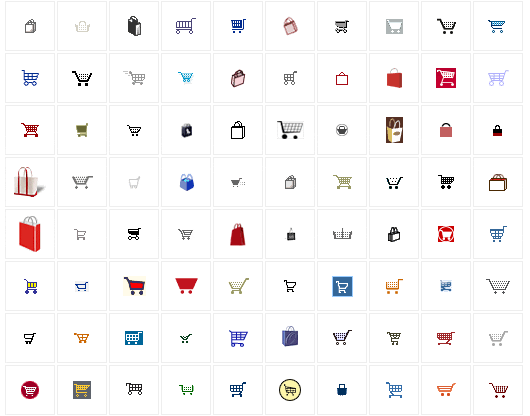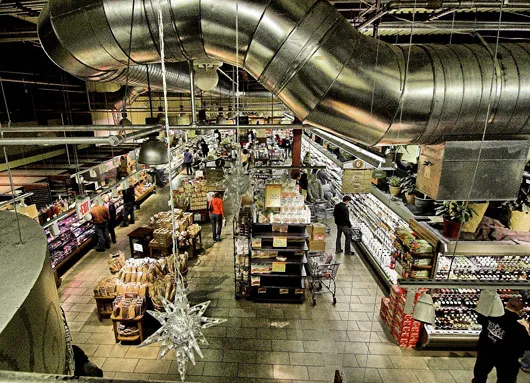We are living in the future and we find it boring. The best place to gather evidence for this claim is the supermarket. To begin with, try and have a fresh look at the word: Supermarket, it is such an utterly futuristic word, yet we use it mindlessly.
If only the supermarket wasn’t such a mundane part of our life, we would realize how exceptional this environment really is.
As an experiment, imagine we would take a caveman – the hunter-gatherer type that lived 40.000 years ago – and put him in a time machine with the final destination: the supermarket around the corner of the street where you live. Surely our friend the cavemen would be astonished after opening the capsule.

Overwhelmed by the hi-res environment of saturated colors he would likely assume he was no longer on Earth. The vast majority of objects in the shop would not make sense whatsoever. Body lotion? Shaving cream? Washing powder? No thank you.
Except for the fruit department – which is merely stunning by its huge variety – the majority of the food products would not even be recognized as food. Coke bottles? Cereals? Toast? Milk from carton packages? Powdered soup? Sausages? All mysteries.
Possibly the meat department could bring our cavemen into an understanding and appreciation of our 21st century consumer culture. As far as he would recognize the meat as meat – nowadays it has become so abstract we hardly recognize the animal in it anymore – he would find the availability of preprocessed chopped pieces quite an improvement on his own painstaking food production efforts. Hunting and gathering is easy in the supermarket: Stone axes and javelins are replaced by shopping carts. Just run around and gather the stuff you need.

Image: Iconesque web images of shopping carts and bag icons gathered by Ro London
Who knows after some further explorations, our time traveling caveman would conclude he was transferred into heaven – or some likewise caveman concept of an ideal world.
Undoubtedly there would still be many mysteries and surprises. Our caveman would not realize straight away that it requires money, which has to be gathered elsewhere in some daytime job, to pay for all the treats – how utterly complex and inconvenient!
Also, he would be clueless on where the foods come from and how they are produced. But then again, that’s one mystery we share with the caveman: of the vast majority of the products we buy we haven’t got the slightest idea where and how they are born.
One wonders how the caveman would look at us – those oddly dressed cart–pushing–beings, with t-shirts, sneakers and haircuts, he would bump into between the shelves. Certainly he would perceive us as peculiar people; possibly he would not even see us ‘humans’, but rather as ‘post-human beings’ of some sort.
Obviously he would be mistaken then, as we are humans just like him: Genetically we are not different from cavemen, only our environment has changed. It is just that unlike our friend the caveman, we are living in the future.

Whole foods & the chocolate waterfall
Humans evolved in an environment where food had to be gathered and hunted and in many respect the concept of the supermarket is just as outlandish for us as for a caveman.
Looking at the recent developments in supermarket design it becomes apparent that, intuitively or not, retailers understand that the supermarket is our next savanna and that it should be designed as such. Moving from warehouses stacked with boxes, supermarkets are increasingly transformed into ‘experiences’ where the consumers can wonder and gather around to fulfill their needs, while at the same time establishing a relation with the environment.
All offerings are kept and presented in its purest state, avoiding artificial additives, sweeteners, colorings, and preservatives. Consumers can choose from six different types of chicken, which are all organically bred. Amidst the products videos are shown on how the products are grown.

Image from the movie "Charlie and the Chocolate Factory" (2005).
Shopping at Whole Foods remotely reminds one of Roald Dahl’s book ‘Charlie and the Chocolate factory’, which main attraction is the Chocolate Room in which everything is edible: the pavements, the bushes, even the grass. There even is a chocolate river, where the chocolate is mixed and churned by the waterfall.
Although the sugar and obesity levels are a lot higher in the Chocolate Room than at Whole Foods Market, the offerings at both places are organically and naturally grown Willy Wonka even proclaims this as his unique selling point: "There is no other factory in the world that mixes its chocolate by waterfall." A chocolate waterfall! Can it get any more organic than that?
Perhaps in the long run, supermarkets will become more like savannas again. A place for to hunt, gather, farm and have a picnic with the family. If this ever happens, we would be full circle. Not so much back, but rather forward to nature.


Comments (0)
Share your thoughts and join the technology debate!
No comments yet
Be the first to share your thoughts!